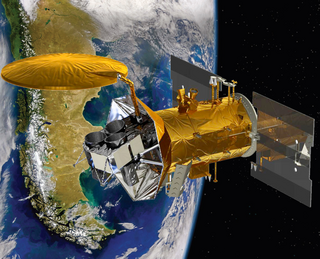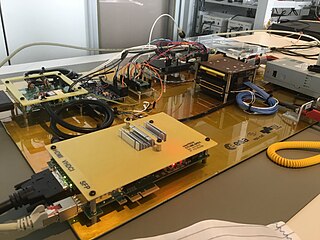
A robotic spacecraft is an uncrewed spacecraft, usually under telerobotic control. A robotic spacecraft designed to make scientific research measurements is often called a space probe. Many space missions are more suited to telerobotic rather than crewed operation, due to lower cost and lower risk factors. In addition, some planetary destinations such as Venus or the vicinity of Jupiter are too hostile for human survival, given current technology. Outer planets such as Saturn, Uranus, and Neptune are too distant to reach with current crewed spacecraft technology, so telerobotic probes are the only way to explore them.

Envisat is a large inactive Earth-observing satellite which is still in orbit. Operated by the European Space Agency (ESA), it was the world's largest civilian Earth observation satellite.
Mars 2MV-4 No.1 also known as Sputnik 22 in the West, was a Soviet spacecraft, which was launched in 1962 as part of the Mars programme, and was intended to make a flyby of Mars, and transmit images of the planet back to Earth. Due to a problem with the rocket which launched it, it was destroyed in low Earth orbit. It was the first of two Mars 2MV-4 spacecraft to be launched, the other being the Mars 1 spacecraft which was launched eight days later.
Mars 2MV-3 No.1 also known as Sputnik 24 in the West, was a Soviet spacecraft, which was launched in 1962 as part of the Mars program, and was intended to land on the surface of Mars. Due to a problem with the rocket which launched it, it did not depart low Earth orbit, and it decayed several days later. It was the only Mars 2MV-3 spacecraft to be launched.
Kosmos is a designation given to many satellites operated by the Soviet Union and subsequently Russia. Kosmos 1, the first spacecraft to be given a Kosmos designation, was launched on 16 March 1962.

The Phobos program was an unmanned space mission consisting of two probes launched by the Soviet Union to study Mars and its moons Phobos and Deimos. Phobos 1 was launched on 7 July 1988, and Phobos 2 on 12 July 1988, each aboard a Proton-K rocket.

The Tracking and Data Relay Satellite System (TDRSS) is a network of American communications satellites and ground stations used by NASA for space communications. The system was designed to replace an existing network of ground stations that had supported all of NASA's manned flight missions. The prime design goal was to increase the time spacecraft were in communication with the ground and improve the amount of data that could be transferred. Many Tracking and Data Relay Satellites were launched in the 1980s and 1990s with the Space Shuttle and made use of the Inertial Upper Stage, a two-stage solid rocket booster developed for the shuttle. Other TDRS were launched by Atlas IIa and Atlas V rockets.

TOPEX/Poseidon was a joint satellite mission between NASA, the U.S. space agency; and CNES, the French space agency, to map ocean surface topography. Launched on August 10, 1992, it was the first major oceanographic research satellite. TOPEX/Poseidon helped revolutionize oceanography by providing data previously impossible to obtain. Oceanographer Walter Munk described TOPEX/Poseidon as "the most successful ocean experiment of all time." A malfunction ended normal satellite operations in January 2006.
Venera 2MV-2 No.1, also known as Sputnik 21 in the West, was a Soviet spacecraft, which was launched in 1962 as part of the Venera programme, and was intended to make a flyby of Venus. Due to a problem with the rocket which launched it, it failed to leave low Earth orbit, and reentered the atmosphere a few days later. It was the second Venera 2MV-2 spacecraft, both of which failed to leave Earth orbit.

Spacecraft operating in the inner Solar System usually rely on the use of photovoltaic solar panels to derive electricity from sunlight. Outside the orbit of Jupiter, solar radiation is too weak to produce sufficient power within current solar technology and spacecraft mass limitations, so radioisotope thermoelectric generators (RTGs) are instead used as a power source.

The Time History of Events and Macroscale Interactions during Substorms (THEMIS) mission began in February 2007 as a constellation of five NASA satellites to study energy releases from Earth's magnetosphere known as substorms, magnetic phenomena that intensify auroras near Earth's poles. The name of the mission is an acronym alluding to the Titan Themis.
The NASA Space Science Data Coordinated Archive (NSSDCA) serves as the permanent archive for NASA space science mission data. "Space science" includes astronomy and astrophysics, solar and space plasma physics, and planetary and lunar science. As the permanent archive, NSSDCA teams with NASA's discipline-specific space science "active archives" which provide access to data to researchers and, in some cases, to the general public. NSSDCA also serves as NASA's permanent archive for space physics mission data. It provides access to several geophysical models and to data from some non-NASA mission data. NSSDCA was called the National Space Science Data Center (NSSDC) prior to March 2015.

Aquarius was a NASA instrument aboard the Argentine SAC-D spacecraft. Its mission was to measure global sea surface salinity to better predict future climate conditions.

The Glory satellite was a planned NASA satellite mission that would have collected data on the chemical, micro-physical and optical properties—and the spatial and temporal distributions—of sulfate and other aerosols, and would have collected solar irradiance data for the long-term climate record. The science focus areas served by Glory included: atmospheric composition; carbon cycle, ecosystems, and biogeochemistry; climate variability and change; and water and energy cycles. The US$424 million satellite was lost on 4 March 2011, when its Taurus XL carrier rocket malfunctioned. A subsequent investigation revealed that the fairing system failed to open fully, causing the satellite to reenter the atmosphere at which point it likely broke up and burned. NASA investigators later determined the cause for the launch failure to be faulty materials provided by aluminum manufacturer Sapa Profiles.

Soyuz TMA-15 was a crewed spaceflight to the International Space Station. Part of the Soyuz programme, it transported three members of the Expedition 20 crew to the space station. TMA-15 was the 102nd crewed flight of a Soyuz spacecraft, since Soyuz 1 in 1967. The Soyuz spacecraft remain docked to the space station during Expedition 20 and Expedition 21 as an emergency escape vehicle. The mission marked the start of six-person crew operations on the ISS.

The Magnetospheric Multiscale Mission (MMS) is a NASA robotic space mission to study the Earth's magnetosphere, using four identical spacecraft flying in a tetrahedral formation. The spacecraft were launched on 13 March 2015 at 02:44 UTC. The mission is designed to gather information about the microphysics of magnetic reconnection, energetic particle acceleration, and turbulence—processes that occur in many astrophysical plasmas. As of March 2020, the MMS spacecraft have enough fuel to remain operational until 2040.
The Manned Space Flight Network was a set of tracking stations built to support the American Mercury, Gemini, Apollo, and Skylab space programs.
SSETI Express was the first spacecraft to be designed and built by European students and was launched by the European Space Agency. SSETI Express is a small spacecraft, similar in size and shape to a washing machine. On board the student-built spacecraft were three CubeSat pico-satellites, extremely small satellites weighing around one kg each. These were deployed one hour and forty minutes after launch. 23 university groups, working from locations spread across Europe and with very different cultural backgrounds, worked together via the internet to jointly create the satellite. The expected lifetime of the mission was planned to be 2 months. Express is the fastest developed micro-satellite in history.

Two Wide-Angle Imaging Neutral-Atom Spectrometers (TWINS) are a pair of NASA instruments aboard two United States National Reconnaissance Office satellites in Molniya orbits. TWINS was designed to provide stereo images of the Earth's ring current. The first instrument, TWINS-1, was launched aboard USA-184 on 28 June 2006. TWINS-2 followed aboard USA-200 on March 13, 2008.

OPS-SAT is a CubeSat by the European Space Agency (ESA) and it is intended to demonstrate the improvements in mission control capabilities that will arise when satellites can fly more powerful on-board computers. The satellite features an experimental computer that is ten times more powerful than any current ESA spacecraft.












